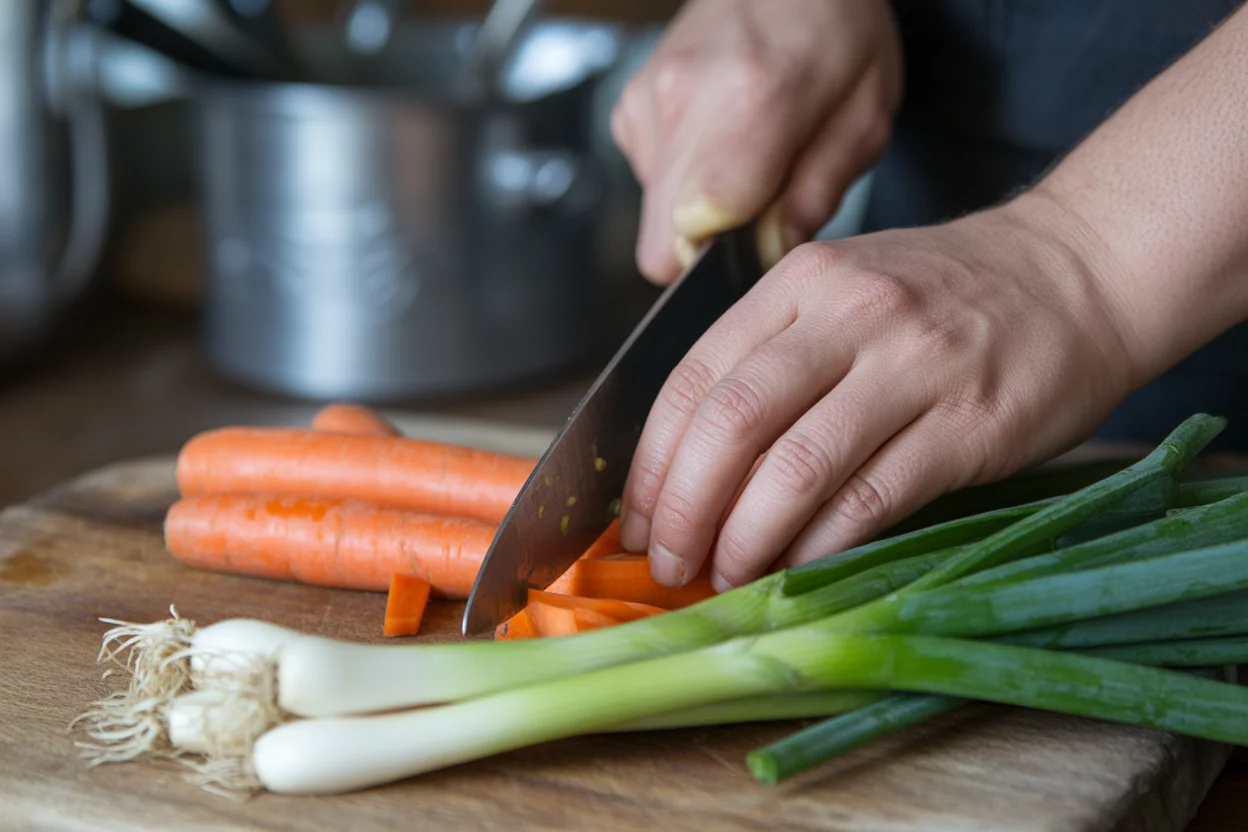Ever had one of those days when Filipino sotanghon soup is the only answer? Like when it’s raining sideways or the air-con is set to arctic. You don’t want to mess around with some fancy, fussy pot. You just need that transparent, slurpy warmth to settle your bones and make the world feel a tiny bit less cruel. Oh, and the stuff is way healthier than you might expect — I learned that when poking through some healthy Filipino recipes last winter and now I swear by adding veggies. Honestly, it’s as comforting as classic adobo, which you can twist up a hundred ways if you like experimenting with Filipino favorites. Okay, let’s pull up a kitchen stool and get into it.

Benefits of sotanghon
So first things first, you might wonder… is chicken sotanghon soup just a cuddle in a bowl, or what? Dang right it is. But here’s the kicker: it’s loaded with light protein, fresh veg, and vermicelli noodles (they’re glass noodles, super fun texture). This is the kind of meal you can feed the entire barangay—everyone from grandma to picky toddlers will be elbow-deep in it. The soup kind of reminds you of beef bulalo but way less heavy. After a single bowl my mood always lifts (can’t explain it, it just happens).
My tita swears it’s good for your immune system due to the ginger and garlic. I honestly think she’s onto something. Plus, it saves the day if someone’s under the weather, no fibbing. Whether it’s for lunch, a quiet dinner, or post-party drunchies, chicken sotanghon soup fits the bill. Comfort without the food crash.

Gathering ingredients
Right, I’ll say it upfront: you don’t need to empty your wallet at the grocery store. Here’s what you really need for solid comfort:
Chicken pieces (bone-in is best—adds flavor, but go boneless if you’re in a rush)
A bundle of sotanghon noodles—sometimes labeled “mung bean vermicelli”
Some aromatics: garlic, onion, and ginger (don’t skip these, honestly)
Carrots for color, cabbage or even spinach for the green kick
Fish sauce (the real MVP for Filipino cooking)
Simple pantry stuff: ground pepper and maybe a dash of patis if you like that extra salty kick
That’s it. No need for wild substitutes. I hate recipes with ten million ingredients too—so breathe easy.
Cooking chicken
Here’s where the real flavor magic happens. Always start with a good sear if you have the time. Browning the chicken with ginger and garlic? It just pulls out a deeper taste (seriously, use this trick for any Filipino soup you make). Once things get fragrant, in goes the water. Let the chicken simmer until it’s tender, falling off the bone, threatening to dissolve (okay, maybe not that dramatic, but almost). This is the backbone of the soup, by the way.
I once rushed this step—regret city. Trust me, ten extra minutes will have you licking your spoon for every drop. The broth sucks up all those meaty chicken flavors.
“My mom always said, ‘If the chicken smells right with ginger, the soup will hug you all day.’ She’s not wrong.”
Preparing vermicelli noodles
Alright, the noodles. Don’t be scared. These little clear guys need some love but not too much. Dump them in a bowl, pour super hot water over them, and wait maybe five minutes? They’ll go from stick-straight to bouncy and soft. Give ‘em a snip so they’re easier to serve, or don’t—some people love the extra-long tangle.
The key is to soak, not boil. If you cook them too long, they just vanish into goo. (Happened to me more than once. Oops.) Drain and set aside once they hit the sweet spot. They’ll keep soaking up the broth when they’re in the soup.
Combining soup elements
This is where the kitchen starts smelling like home—can’t help it. Toss those dreamy carrots and cabbage right into the simmering chicken pot. Now, slide those softened noodles in and watch the whole pot transform into something that looks like you ordered from a five-star Filipino turo-turo. Don’t forget a taste test (tiny sip, you won’t burn off your tongue).
Everything comes together fast. The noodles soak up the chicken flavor, the veggies stay bright, and suddenly you’ve got dinner that makes people come running. If you’re feeling wild, I sometimes splash in a bit of annatto oil for that punchy orange color.
Seasoning and serving
Before bringing your masterpiece to the table, make sure you give it a final taste. This is your chance to add personality—patis, calamansi, black pepper, or even a hint of chili oil if you’re feeling bold.
Here’s a couple serving tricks I’ve totally stolen from my aunties:
- Top with crispy garlic or fried onions for crunch.
- Add a boiled egg half, ramen-style, just because.
- Serve with a side of garlic sinangag for a hearty lunch.
- Pair with sawsawan (dipping sauce) if you love that extra salty-tangy zing.
Give it a try, then let everyone personalize their bowl. That way, picky eaters and spicy-food lovers can both be happy.
Storage instructions
You’ve made a giant pot. Happens to the best of us. Good news: chicken sotanghon soup keeps really well for about three days in the fridge. Just dunk it in a microwave-safe bowl, zapped for a couple minutes, and it’ll taste almost as good as day one.
Heads up, though. The noodles will slurp up more soup as they sit, so you might need to add extra water or broth when you reheat. I also save a little extra fresh cabbage or spinach to throw in before eating—makes leftovers feel way fresher.
Don’t freeze, by the way. The noodle texture goes from awesome to strange faster than you can say “did someone microwave a slipper?”

Common Questions
Do I have to use chicken breast?
Nope, thighs or drumsticks have tons more flavor. I use what’s cheapest or hiding in my freezer.
Can I add other veggies?
For sure. I toss in snow peas, baby bok choy, or even corn if I’m cleaning out the fridge.
Is sotanghon gluten free?
Usually, yes! Just check the noodle package to be double sure.
What if my broth looks cloudy?
That’s normal, actually. All those good flavors get cozy together—it’s not supposed to be crystal clear.
Any way to get my kids to eat more veggies in this?
Brother, have you seen these kid-friendly Filipino dishes? But seriously, chop veggies tiny or blend them in. They’ll never know.
So, that’s how I get my cozy comfort fix with chicken sotanghon soup. I’ve honestly slurped more bowls than I can count, and every pot feels a bit like a homecoming. Tried it with old bread, rice, and yeah, even leftover lechon once (no judgment). Curious about a slightly different version? I found some neat tips at Chicken Sotanghon Soup and another take at Chicken Sotanghon Soup – Foxy Folksy. Both are wild in their own right if you’re the adventurous type.
Let me know how your batch goes. Stay warm, eat well, and seriously—don’t stress the details. Happy cooking!
Chicken Sotanghon Soup
Ingredients
For the Soup Base
- 1 lb Bone-in chicken pieces Best for flavor; boneless chicken can be used if in a hurry.
- 8 cups Water Needed for simmering the chicken.
- 2 tbsp Fish sauce Adds authentic salty depth.
- 1 tbsp Ground pepper To taste.
Aromatics
- 4 cloves Garlic Minced.
- 1 medium Onion Chopped.
- 2 inches Ginger Sliced.
Vegetables
- 1 cup Carrots Chopped.
- 2 cups Cabbage Chopped; can substitute with spinach.
For the Noodles
- 1 pack Sotanghon noodles Also known as mung bean vermicelli.
Instructions
Cooking Chicken
- In a pot, sear the chicken pieces with minced garlic and sliced ginger until fragrant.
- Add water, cover, and simmer until the chicken is tender and falling off the bone.
Preparing Noodles
- Soak the sotanghon noodles in hot water for about five minutes until they become soft.
- Snip them if desired, then drain and set aside.
Combining Ingredients
- Add chopped vegetables (carrots and cabbage) to the chicken pot.
- Stir in the softened noodles and mix well.
- Taste for seasoning and adjust with fish sauce or pepper as needed.
Serving
- Serve hot, garnished with crispy garlic or fried onions, and optionally a boiled egg half.


2 thoughts on “Comforting Chicken Sotanghon Soup with Vermicelli Noodles”